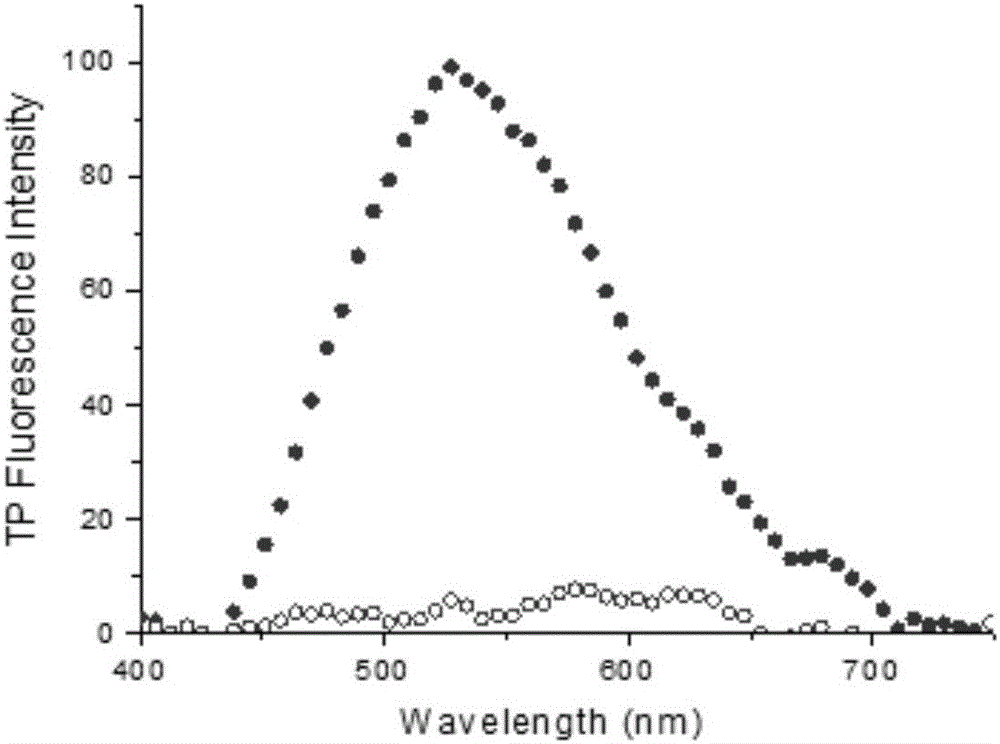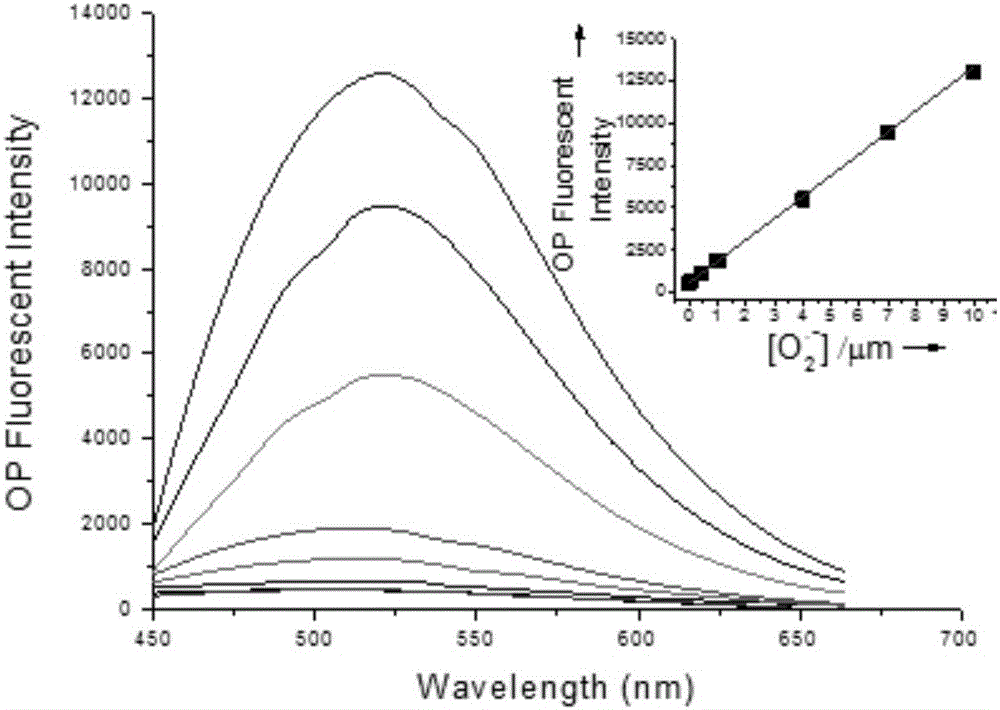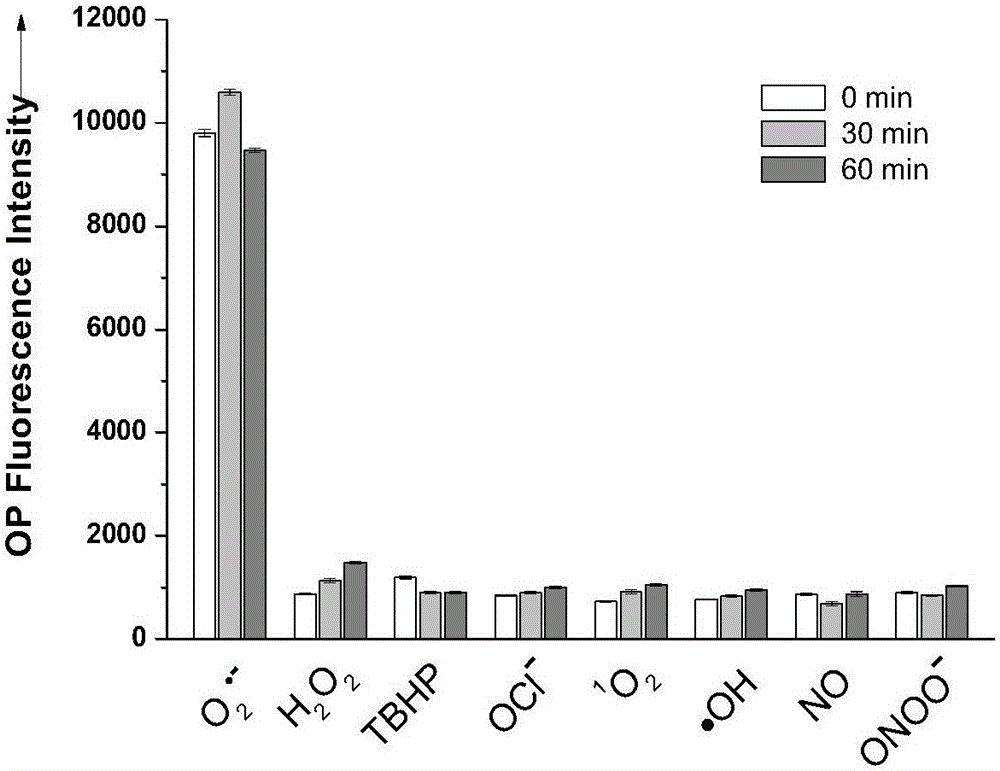Fluorescent probe as well as preparation method and application thereof
A fluorescent probe and reaction technology, used in fluorescence/phosphorescence, chemical instruments and methods, luminescent materials, etc., can solve the problem of lack of TP fluorescent probes, and achieve good photophysical stability, easy purification, and simple synthesis steps. Effect
- Summary
- Abstract
- Description
- Claims
- Application Information
AI Technical Summary
Problems solved by technology
Method used
Image
Examples
Embodiment 1
[0044] Embodiment 1: the synthesis of PY-NH2
[0045] Proceed as follows:
[0046] 2,5-bis(4'-aminostyryl)pyrazine (PY-NH2): p-nitrobenzaldehyde (7.55g, 0.05mol), 2,5-dimethylpyrazine ( 3.24 g, 0.01 mol) and phthalic anhydride (7.40 g, 0.05 mol). Heated to 180°C, refluxed for 15 hours, cooled to room temperature, and dissolved with 50 mL of chloroform. After the solution was extracted with 5% sodium hydroxide solution, the organic layer was separated by silica gel column chromatography (eluent: n-hexane / ethyl acetate=2 / 1) to obtain PY-NO2. Add 10ml of sodium polysulfide to PY-NO2, and reflux in ethanol solution for 3 hours to obtain PY-NH2.
[0047] PY-NH2. 1 HNMR(400MHz,DMSO):δ8.55(s,4H),δ8.43(s,2H),δ7.56(d,J=16.0,2H),δ7.35(d,J=8.0,4H) ,δ6.99(d,J=16.0,2H),δ6.59(d,J=8.0,4H); 13 CHNMR (400MHz, DMSO): δ150.27, 144.11, 142.27, 134.29, 129.08, 129.01, 118.95, 114.31; MSdata, m / zcalcdfor[C 20 h 18 N 4 +H]315.1565,found315.1600.
Embodiment 2
[0048] Embodiment 2: the synthesis of fluorescent probe
[0049] The synthesis steps of PY-CA are as follows: PY-NH2 (0.314g, 1.0mmol), caffeic acid (0.525g, 3.0mmol), triethylamine (1.0mL), HOBT (0.636g, 3.0mmol) were added to a 250mL three-necked flask and EDC (0.576 g, 3.0 mmol) into a mixed solvent of dichloromethane (8.0 mL) and DMF (1.2 mL). Under the protection of argon, the mixture was stirred overnight at room temperature to obtain a crude product. After part of the solvent was removed by rotary evaporation, the product was separated by thin layer chromatography (silica gel GF 254 ), the eluent was toluene / methanol / ethyl acetate=4 / 0.5 / 2, and a yellow product was obtained.
Embodiment 3
[0050] Embodiment 3: the synthesis of fluorescent probe
[0051] The synthesis steps of PY-CA are as follows: PY-NH2 (1.0mmol), caffeic acid (2.0mmol), triethylamine (1.0mL), HOBT (2.0mmol) and EDC (3.5mmol) were added to a 250mL three-necked flask to dichloro In a mixed solvent of methane (8.0 mL) and DMF (3.0 mL). Under the protection of argon, the mixture was stirred overnight at room temperature to obtain a crude product. After part of the solvent was removed by rotary evaporation, the product was separated by thin layer chromatography (silica gel GF 254 ), the eluent was toluene / methanol / ethyl acetate=6 / 1 / 4, and a yellow product was obtained.
[0052] PY-CA. 1 HNMR (400MHz, DMSO): δ8.30(s, 2H), δ8.16(d, J=8.0, 4H), δ7.92(d, J=8.0, 4H), δ7.9278(d, J= 16.0,2H),δ7.63(d,J=8.0,4H),δ7.47(d,J=16.0,2H),δ7.45(d,J=16.0,2H),δ7.43(s, 4H), δ7.37(d, J=16.0, 2H), δ7.35(s, 4H); 13 CHNMR (400MHz, DMSO): δ164.38, 162.96, 143.24, 132.48, 132.03, 129.58, 129.13, 128.26, 127.94, 125.96,...
PUM
 Login to View More
Login to View More Abstract
Description
Claims
Application Information
 Login to View More
Login to View More - R&D
- Intellectual Property
- Life Sciences
- Materials
- Tech Scout
- Unparalleled Data Quality
- Higher Quality Content
- 60% Fewer Hallucinations
Browse by: Latest US Patents, China's latest patents, Technical Efficacy Thesaurus, Application Domain, Technology Topic, Popular Technical Reports.
© 2025 PatSnap. All rights reserved.Legal|Privacy policy|Modern Slavery Act Transparency Statement|Sitemap|About US| Contact US: help@patsnap.com



